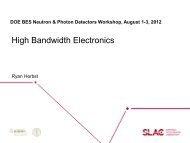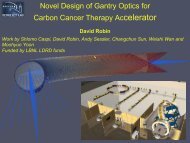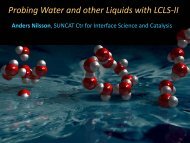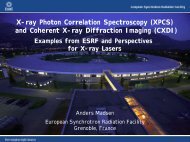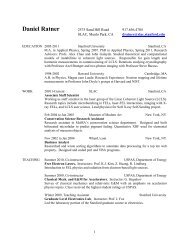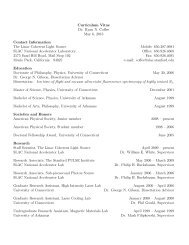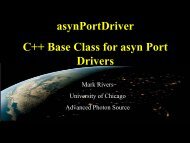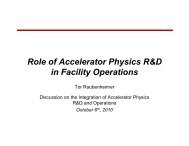SXR Technical Design Report - Stanford University
SXR Technical Design Report - Stanford University
SXR Technical Design Report - Stanford University
Create successful ePaper yourself
Turn your PDF publications into a flip-book with our unique Google optimized e-Paper software.
Dear <strong>SXR</strong> representative,<br />
This letter describes the intention to install, operate and support a fully equipped endstation at the Soft X-<br />
ray for Material Science (<strong>SXR</strong>) beamline at LCLS. The endstation will comply with the requirements<br />
outlined in chapter 5 of the <strong>SXR</strong> <strong>Technical</strong> <strong>Design</strong> <strong>Report</strong> and will be available for extended periods of<br />
time (months) per year at the <strong>SXR</strong> beamline for experiments conducted within the experimental<br />
collaboration between S. Techert (MPI for biophysical chemistry, Göttingen), A. Föhlisch (Institute for<br />
Experimental Physics, Hamburg <strong>University</strong>), F. Hennies (Max-Lab, Lund <strong>University</strong>), by other <strong>SXR</strong><br />
collaborators, in particular A. Nilsson and K. Gaffney (<strong>Stanford</strong> <strong>University</strong>) and P. Wernet (Bessy, Berlin)<br />
as well as by outside users via LCLS experiment proposals.<br />
The experimental station to study chemical dynamics in the liquid phase is based on a differentially<br />
pumped liquid jet system, developed at the MPI of biophysical chemistry. With a Rowland-type soft X-ray<br />
spectrometer (Grace 3) X-ray emission spectroscopy is conducted using three gratings, effectively covering<br />
the energy range between 50eV< hv < 1500 eV. Thus detailed investigations of the valence electronic<br />
structure and the chemical state for chemically and biologically relevant molecular dynamics are accessible<br />
both with resonant and non-resonant X-ray emission spectroscopy. In particular the local valence electronic<br />
structure of carbon, nitrogen and oxygen, as well as transition and rare earth metals can be investigated.<br />
Femtosecond temporal resolution to study photoinduced dynamics will be achieved in an optical-pump/Xray-probe<br />
set-up, using the collinear optical incoupling and the tools for X-ray/optical cross-correlation<br />
developed at Hamburg <strong>University</strong>. Additionally, X-ray induced radiation chemistry can be investigated<br />
through femtosecond time resolved X-ray-pump/optical-probe spectroscopy.<br />
The liquid beam set-up is shown below with schematic illustrations of prototypical chemical dynamics that<br />
will become accessible with this facility. This station will be thoroughly tested at the Free-Electron LASer<br />
at Hamburg FLASH and the X-ray spectrometer and associated diagnostics will be characterized at Max-<br />
Lab Sweden. In particular we will develop the hardware and software, which we currently employ at<br />
FLASH further and optimize for the operating conditions at LCLS.<br />
Dissoziation<br />
~ 1Å / 100 fs.<br />
Isomerization<br />
> 200 fs.<br />
36



